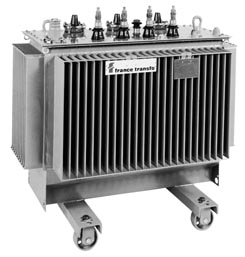Transformer winding resistance is very important factor for the life of any transformer, this test is part of type tests, routine tests and field tests. The purpose of winding resistance test is to determine the following:
- Calculation of the I2R losses in transformer.
- Calculation of winding temperature at the end of temperature rise test of transformer.
- As a benchmark for assessing possible damages in the field.
Typically transformer winding resistance test is performed at the installation site in order to check for abnormalities due to loose connections, broken strands of conductor, high contact resistance in tap changers, high voltage leads and bushings.
On the other hand prior to dispatch the transformer out of the factory, each transformer is routine tested which is witnessed by a representative from the potential customers as required. The routine tests of the transformers include:
- Measurement of each winding resistance and temperature at full load.
- The voltage ratio shall be measured on each tapping.
- The impedance voltage shall be measured in accordance to IEC76 – Power Transformers. The impedance voltage should be corrected to the reference temperature of 75 deg C.
- The no load and full load losses of the transformers are also need checking.
- The transformer is checked for source voltage withstand test.
- Partial Discharge test to IEC 270.
- Transformer noise measurement.
- Functional test for all setting point for alarm and trip value.
Transformer Winding Resistance Measurement Method
In the scenario of star connected winding, the resistance shall be measured between the line and neutral terminal and for star connected auto transformers the resistance of the HV side is measured between HV terminal and IV terminal, then between IV terminal and the neutral. On the other hand delta connected windings, measurement of winding resistance shall be done between pairs of line terminals. As in delta connection the resistance of individual winding can not be measured separately, the resistance per winding shall be calculated as per the following formula:
Winding Resistance at standard temperature of 75oC
t = Winding temperature.
Generally transformer windings are immersed in insulation liquid and covered with paper insulation, hence it is impossible to measure the actual winding temperature in a de-energizing transformer at time of transformer winding resistance measurement. An approximation is developed to calculate temperature of winding at that condition, as follow.
Current Voltage Method of Measurement of Winding Resistance
The transformer winding resistances can be measured by current voltage method. In this method of measurement of winding resistance, the test current is injected to the winding and corresponding voltage drop across the winding is measured. By applying simple Ohm’s law i.e. Rx= V ⁄ I, one can easily determine the value of resistance.
Procedure of Current Voltage Method of Measurement of Winding Resistance
- Before measurement the transformer should be kept in OFF condition without excitation at least for 3 to 4 hours. This is required for cooling purpose and winding temperature will become equal to its oil temperature.
- Measurement is done with D.C.
- To minimize observation errors, polarity of the core magnetization shall be kept constant during all resistance readings.
- Voltmeter leads shall be independent of the current leads to protect it from high voltages which may occur during switching on and off the current circuit.
- The readings shall be taken after the current and voltage have reached steady state values. In some cases this may take several minutes depending upon the winding impedance.
- The test current shall not exceed 15% of the rated current of the winding. Large values may cause inaccuracy by heating the winding and thereby changing its resistance.
- For expressing resistance, the corresponding temperature of the winding at the time of measurement must be mentioned along with resistance value. As we said earlier that after remaining in switch off condition for 3 to 4 hours, the winding temperature would become equal to oil temperature. The oil temperature at the time of testing is taken as the average of top oil and bottom oil temperatures of transformer.
- For star connected three phase winding, the resistance per phase would be half of measured resistance between two line terminals of the transformer.
- For delta connected three phase winding, the resistance per phase would be 0.67 times of measured resistance between two line terminals of the transformer.
- This current voltage method of measurement of winding resistance of transformer should be repeated for each pair of line terminals of winding at every tap position.
Bridge Method of Measurement of Winding Resistance
The main principle of bridge method is based on comparing an unknown resistance with a known resistance. When currents flowing through the arms of bridge circuit become balanced, the reading of galvanometer shows zero deflection that means at balanced condition no current will flow through the galvanometer. Very small value of resistance ( in milli-ohms range) can be accurately measured by Kelvin bridge method whereas for higher value Wheatstone bridge method of resistance measurement is applied. In bridge method of measurement of winding resistance, the error is minimum.

